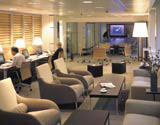Report says workplace designers must hard sell

Designers are missing out on the lucrative workspace market, with two-thirds of office space design still undertaken in-house, according to a survey published last week.
The Management Today-sponsored report highlights a perception that designed spaces are ‘high cost’, with internal facilities and administration departments most likely to undertake the work instead of designers.
According to BDG Workfutures senior associate Jason Turner, designers themselves could shoulder some of the blame for this.
‘Design consultancies could become more pro-active, particularly if clients need convincing. They should work with, not for or against, clients,’ he says.
DEGW director of briefing Nicholas Morgan agrees. ‘It’s up to both [client and consultancy] to engage staff without using design for design’s sake,’ he says.
But BDG Workfutures senior associate Jason Turner says it is a popular misconception that using a workplace design consultancy is costly. ‘In reality, the difference between installing office basics and thinking more carefully about interior design is financially very slim.’
He says the main costs in creating an office, ‘between one third and half of the total’, are setting up facilities such as IT networks and air-conditioning.
‘Designers’ fees, as part of the overall project, are a small percentage, and the results of using a consultancy outweigh any costs,’ Turner adds.
However, according to the survey designers are failing to communicate these benefits and workplace design remains a low priority, particularly for private sector employers, despite a high demand for improved facilities by British managers.
Top of managers’ wish-lists is the provision of break-out areas. Over half of those questioned in the report wanted to be able to escape from their desks to relax, think and meet other colleagues, yet only a fifth can do so.
In some work cultures, escape is vital. BBC head of design John Dee is currently working with DEGW on interiors at the corporation’s new White City complex. Roof terraces, he says, are great places to stop and exchange ideas, which in the creative world is critical. Here, the distinction between ‘work’ and ‘time off’ is blurred.
As well as relaxation areas, managers interviewed said they would prefer a cultural activity in their workplace in preference to facilities such as showers, which ‘says something about the need to have civilising distractions from the pressures of the job’, according to the study.
Some companies already do this. Scarlet Projects works regularly with Bloomberg to curate installations within its offices. The latest, which opened last week, features furniture from Buckinghamshire Chilterns University College. Bloomberg staff participate in the installations and are involved in the design process.
The public sector emerged in the study as more ‘likely to have facilities such as a gym or shower’ and encourage flexible work practices than the private sector. ‘The public sector has traditionally had fewer pressures of efficiency and performance, but that is changing,’ Morgan says, who is working with public sector clients HM Treasury and the BBC.
-
Post a comment



